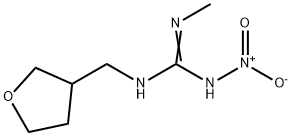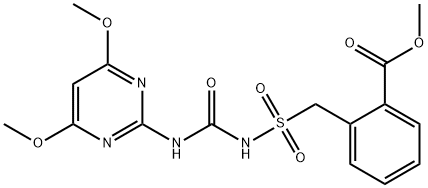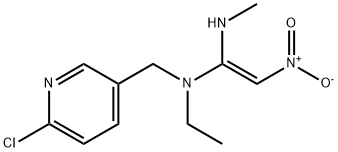Dinotefuran
Synonym(s):(RS)-N-Methyl-N′-nitro-N″-[(tetrahydro-3-furanyl)methyl]guanidine
- CAS NO.:165252-70-0
- Empirical Formula: C7H14N4O3
- Molecular Weight: 202.21
- MDL number: MFCD06795001
- EINECS: 605-399-0
- SAFETY DATA SHEET (SDS)
- Update Date: 2025-01-27 09:38:02

What is Dinotefuran?
Description
Dinotefuran is a broad-spectrum insecticide, which is proposed for food uses in/on leafy vegetables (except Brassica) (group 4), and for use in professional turf management, professional ornamental production, and in the residential indoor, pet, lawn and garden markets. Dinotefuran is a neonicotinoid in the nitroguanidine sub-class, same as another insecticide clothianidin.
Chemical properties
Technical dinotefuran is an odorless white crystalline solid. It has a solubility of 39.83 g/L in water, and is highly soluble in dichloromethane, acetone, methanol, and ethyl acetate. Technical dinotefuran has a melting point of 107.5°C, and a log Pow of -0.549 at 25°C. It is nonflammable, is not explosive to thermal, shock and frictional tests, and has a vapor pressure of <1.7 x 10-6 Pa at 25°C.
The Uses of Dinotefuran
Dinotefuran is a contact insecticide without systemic effect that belongs to the chemical class of the neonicotinoids, which are among the most widely used insecticides in the world. It is highly effective against fleas but not against ticks or mites, or any internal parasites.
It is often used in combination with a tickicide/acaricide (e.g. permethrin) or with an insect growth regulator (e.g. pyriproxyfen). So far it is not used in livestock or horses.
The Uses of Dinotefuran
Dinotefuran is a neonicotinoid insecticide. Useful in cannabis testing kits as a component of pesticide mixes (P698240).
Flammability and Explosibility
Not classified
Agricultural Uses
Dinotefuran is an insecticide: Controls insect pests such as aphids, whiteflies, thrips, leafhopper, leafminer, sawfly, mole cricket, white grubs, lacebugs, billbugs, beetles, mealybugs, sawfly larvae, and cockroaches in leafy vegetables, in residential and commercial buildings, outdoor uses for professional turf management, turf farms, professional ornamental production, golf courses, residential indoor, lawn and garden use [83] . Not listed for use in EU countries. Actively registered in the U.S. and other countries.
Trade name
ALBARIN®; MIKEBLOCK MTI-446®; SAFARI®; SPARKLE®; VENOM®
Pharmacokinetics
After topical administration to dogs and cats dinotefuran remains mostly on the animal's surface and is not absorbed. However a certain amount can be ingested through licking and grooming. In laboratory animals ingested dinotefuran was almost completely absorbed (>90%) quickly distributed throughout the whole body and also rapidly eliminated, mostly through urine in the form of unchanged dinotefuran.
Carcinogenicity
Dinotefuran has been classified as —Not likely to be carcinogenic to humans.“ This classification is based on the lack of evidence for carcinogenicity in mice and rats.
Environmental Fate
Dinotefuran is nontoxic to birds, mammals, fish and algae, but it is highly toxic to marine/estuarine mysid shrimp.
Dinotefuran is highly toxic to honey bees by all routes of administration.
The mean aerobic biodegradation half-life of dinotefuran measured in 2 soils was 81.5 days. If released into water, dinotefuran is not expected to adsorb to suspended solids and sediment.
Dinotefuran was stable to hydrolysis over the pH range of 4 to 9, but was rapidly photolyzed in aqueous solution with a half-life of 1.8 days.
Potential for bioconcentration in aquatic organisms is low.
Dinotefuran may potentially be present in drinking water, given its high water solubility, high mobility in soils.
Dinotefuran does not cumulate in the environment or in the food chain.
Correct use of dinotefuran in dogs and cats is unlikely to result in any significant environmental pollution.
Toxicity evaluation
LD50 acute, rats, oral 2450 mg/kg
D50 acute, rabbits, dermal >2000 mg/kg
As a general rule, dogs and cats tolerate dinotefuran quite well.
Dinotefuran is slightly irritant to the eyes and the skin.
Dinotefuran is not carcinogenic, teratogenic or mutagenic.
Seven repeated dermal administrations of dinotefuran to kittens at 1X, 3X and 5X the recommended dose were well tolerated by the animals. Dry skin as well as soft, loose or liquid feces were reported in some treated kittens bur were of transient character.
Properties of Dinotefuran
| Melting point: | 94.5-101.5° |
| Boiling point: | 334.5±34.0 °C(Predicted) |
| Density | 1.42±0.1 g/cm3(Predicted) |
| vapor pressure | 0Pa at 25℃ |
| storage temp. | Inert atmosphere,Store in freezer, under -20°C |
| solubility | Chloroform (Slightly), DMSO (Slightly), Methanol (Slightly) |
| form | neat |
| pka | 3.24±0.50(Predicted) |
| form | Solid |
| color | White to Pale Brown |
| Water Solubility | 39.83g/L at 20℃ |
| Stability: | Light Sensitive |
| InChI | InChI=1S/C7H14N4O3/c1-8-7(10-11(12)13)9-4-6-2-3-14-5-6/h6H,2-5H2,1H3,(H2,8,9,10) |
| EPA Substance Registry System | Dinotefuran (165252-70-0) |
Safety information for Dinotefuran
| Signal word | Warning |
| Pictogram(s) |
 Exclamation Mark Irritant GHS07 |
| GHS Hazard Statements |
H319:Serious eye damage/eye irritation |
| Precautionary Statement Codes |
P264:Wash hands thoroughly after handling. P264:Wash skin thouroughly after handling. P280:Wear protective gloves/protective clothing/eye protection/face protection. P305+P351+P338:IF IN EYES: Rinse cautiously with water for several minutes. Remove contact lenses, if present and easy to do. Continuerinsing. P337+P313:IF eye irritation persists: Get medical advice/attention. |
Computed Descriptors for Dinotefuran
| InChIKey | YKBZOVFACRVRJN-UHFFFAOYSA-N |
| SMILES | N([N+]([O-])=O)C(=NC)NCC1CCOC1 |
New Products
1-Boc-4-cyanopiperidine tert-Butyl carbazate 1-(TERT-BUTOXYCARBONYL)-2-PYRROLIDINONE TETRABUTYLAMMONIUM CYANIDE TETRAHYDRO-2H-PYRAN-3-OL 3-Pyridineacrylic acid Nickel(II) perchlorate hexahydrate, 98% 4-Bromophenylacetonitrile, 95% 3-Bromo-4-fluoroaniline, 97% Sodium tetraborate decahydrate, 98% Palladium(II) acetate, trimer, Pd 99% 4-Bromo-2-chlorotoluene, 97% Tadalafil Clopidogrel bisulfate Sitagliptin Phosphate Monohydrate Cabergoline Fexofinadine HCl Etoricoxib 4-Amino Acetophenone 2-Chloro Acetophenone Amlodipine Base 2,3,5-Triiodobenzoic Acid Pyrrolidine Diiodo PentoxideRelated products of tetrahydrofuran








You may like
-
 165252-70-0 Dinotefuran 99%View Details
165252-70-0 Dinotefuran 99%View Details
165252-70-0 -
 165252-70-0 98%View Details
165252-70-0 98%View Details
165252-70-0 -
 Dinotefuran 98% (HPLC) CAS 165252-70-0View Details
Dinotefuran 98% (HPLC) CAS 165252-70-0View Details
165252-70-0 -
 Dinotefuran CAS 165252-70-0View Details
Dinotefuran CAS 165252-70-0View Details
165252-70-0 -
 Dinotefuran 97% CAS 165252-70-0View Details
Dinotefuran 97% CAS 165252-70-0View Details
165252-70-0 -
 Dinotefuran CAS 165252-70-0View Details
Dinotefuran CAS 165252-70-0View Details
165252-70-0 -
 366789-02-8 Riveroxaban 98%View Details
366789-02-8 Riveroxaban 98%View Details
366789-02-8 -
 Carvedilol 98%View Details
Carvedilol 98%View Details
72956-09-3
